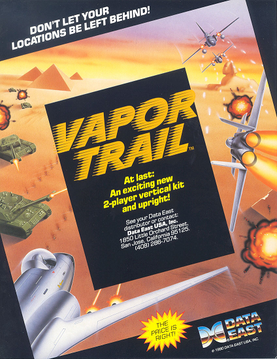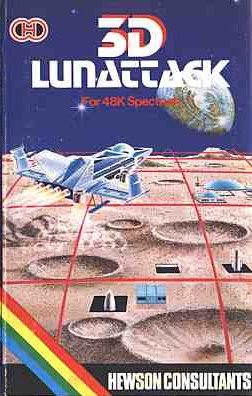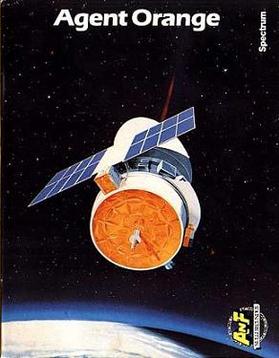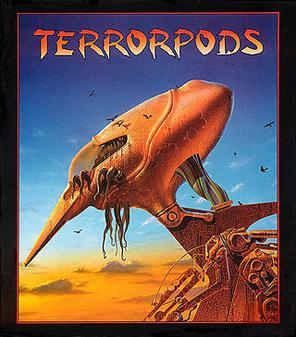
Conquest of the Empire is a military strategy board game set in the Roman Empire after the death of Marcus Aurelius, with 2 to 6 players pitting their armies against each other in an attempt to become the ruler of Rome. The game was created in 1982 by Larry Harris and published by The Citadel under the title VI Caesars. Harris revised the game for Milton Bradley in 1984 to be reissued under the title Conquest of the Empire as part of the Gamemaster series. The game was re-released in the summer of 2005 by Eagle Games, redesigned by Glenn Drover. The gameplay in Conquest of the Empire shares similarities to Axis & Allies, another Larry Harris project within the same series.

Time Crisis 3 is a 2003 light-gun shooter video game developed by Namco and Nextech and published by Namco for arcades. It is the third installment of the Time Crisis series. Like its predecessor, Time Crisis II, it allows for two players to cooperate in a link play environment and has the Time Crisis signature pedal system for hiding and advancing and the first in the series to change or select weapons. It was later ported to the PlayStation 2.

Raid Over Moscow is a video game by Access Software published in Europe by U.S. Gold for the Commodore 64 in 1984 and other microcomputers in 1985-1986.

Battle in Outer Space is a 1959 Japanese science fiction film directed by Ishirō Honda, with special effects by Eiji Tsuburaya.

The Death and Return of Superman is a side-scrolling beat 'em up video game released by Sunsoft for the Super NES and Genesis in 1994. It is based on "The Death of Superman" comic book storyline by DC Comics and features many characters from the comics, including Superman himself, Superboy, Steel, Cyborg Superman, the Eradicator, and Doomsday. All of the five Supermen are playable characters at some point.

Vapor Trail: Hyper Offense Formation, known in Japan as Kuuga – Operation Code Vapor Trail and usually simply referred to as Vapor Trail, is a 1989 shoot 'em up arcade game developed and published by Data East. Vapor Trail was followed by Rohga: Armor Force and Skull Fang.

Sid Meier's Pirates! is a 2004 strategy, action and adventure video game developed by Firaxis Games. A remake of Sid Meier's earlier 1987 game of the same name, it was originally published by Atari Interactive, but in May 2005 2K acquired the rights to the title from Atari's parent company Infogrames and later went on to publish console and handheld ports of the game.
Shienryū (紫炎龍) is a vertical scrolling shooter created by Warashi for the arcade which was released in 1997, later followed by a Sega Saturn console release in 1997 and PlayStation release in 1999 (JP) and 2002 (US).

Revenge from Mars is a pinball machine designed by George Gomez and manufactured by Williams Electronics Games in 1999. It is the sequel to the similarly themed Attack from Mars.

Zektor is a multidirectional shooter arcade video game created by Sega Electronics and released in 1982. It challenges the player to pilot a space ship in a quest to recapture eight different cities that have been captured by alien robots. The robots' dialogue is spoken through speech synthesis.
Ace Online or AirRivals is a free-to-play massively multiplayer online game (MMOG) 3D shooter developed by MasangSoft Inc. and owned by YD Online Corp.

Battleship: Surface Thunder is a PC video game developed by Meyer/Glass Interactive and published by Hasbro Interactive. It was released in the United States on September 12, 2000. The game is split into two modes: the regular classic battleship and a new arcade version that expands on the classic game in the form of a mission-based third-person shooter.

The Seiddab Trilogy is a series of video games designed by Steve Turner for the ZX Spectrum and published by Hewson Consultants. It consists of 3D Space-Wars (1983), 3D Seiddab Attack (1984), and 3D Lunattack. All three games were later published together as The Seiddab Trilogy by Hewson for the Rotronics Wafadrive. The series name is derived from the word "baddies" being spelt in reverse.

Terracon is a 2000 action-adventure video game developed by British studio PictureHouse Software and published by Sony Computer Entertainment for the PlayStation. It was only released in Europe; a North American release by Midway was planned, but it was cancelled for unknown reasons.

Agent Orange is a horizontally scrolling shooter released by A&F Software in January 1987 for the Amstrad CPC, Commodore 64, and ZX Spectrum.

SOCOM 4 U.S. Navy SEALs, known as SOCOM: Special Forces in PAL regions, is a 2011 tactical third-person shooter video game developed by Zipper Interactive and published by Sony Computer Entertainment for the PlayStation 3. It is the sequel to SOCOM U.S. Navy SEALs: Combined Assault and the most recent installment in the SOCOM U.S. Navy SEALs series.

The following outline is provided as an overview of and topical guide to chess:
Independence Day is a franchise of American science fiction action films that started with Independence Day in 1996, which was followed by the sequel, Independence Day: Resurgence in 2016. The franchise revolves around extraterrestrials invading Earth and seeking to eradicate mankind while the remaining human resistance uses everything at their disposal to defeat the invaders and take back the planet. Now considered to be a significant turning point in the history of the Hollywood blockbuster, the original film was released worldwide on July 3, 1996, but began showing on July 2 on limited release as a result of a high level of anticipation among moviegoers. The film grossed over $817.4 million worldwide, becoming the highest-grossing film of 1996 and, briefly, the second-highest-grossing film worldwide of all time behind 1993's Jurassic Park. Currently, it ranks 69th on the list of highest-grossing films, and was at the forefront of the large-scale disaster film and sci-fi resurgence of the mid-late 1990s. The film won the Academy Award for Best Visual Effects and was nominated for the Academy Award for Best Sound Mixing.

Terrorpods is a 1987 shooting game with simple business simulation by Psygnosis. Originally developed for the Amiga and Atari ST, it was later ported to the Commodore 64, ZX Spectrum, Amstrad CPC and MSX.















